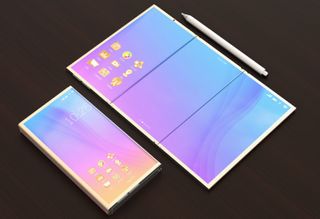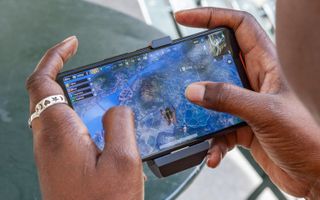Who Gives a Galaxy F? Here’s the Problem with Foldable Phones
With Samsung likely to unveil a foldable smartphone during its developer conference this week, it remains unclear just what purpose such a device would fill.
There's a scene in the 1993 Jurassic Park film where Dr. Ian Malcolm spells out his objections to a theme park built around dinosaurs brought back to life through the magic of DNA: "Your scientists were so preoccupied with whether or not they could that they didn't stop to think if they should."
I think about the sentiment a lot as we hear more and more rumblings about foldable smartphones. Not that the stakes are the same as they were in Jurassic Park — if a foldable phone flops, a velociraptor isn't going to leap out and tear off anyone's face — but because foldable phones strike me as a solution in search of a problem.

Put another way, companies certainly have the wherewithal to build a smartphone that folds any which way. But are there people out there who actually want one?
"I'm having a hard time finding it, to be completely honest," said Ramon Llamas, research director for mobile devices at IDC, when I asked if there's any demand for foldable phones among consumers. "What does a foldable phone provide that current phones do not?"
Samsung looks like it's going to be the next phone maker to try and answer that question. The company holds its annual developers conference in San Francisco tomorrow (Nov. 7), where it's widely expected to preview the Galaxy X, a foldable phone that's been years in the making. The Galaxy X — or the Galaxy F or whatever Samsung ends up calling it — is expected to feature a 7.3-inch screen that can fold in on itself for those times when you don't need a big display.
MORE: Galaxy X Rumors: All About Samsung's Foldable Phone
While Samsung may grab the spotlight this week with its foldable phone demo, it's not going to be the only company working on such a product. Huawei has already said it's working on a foldable phone that its CEO touts as a potential PC replacement. And LG reportedly has a foldable device of its own in the works, which could see the light of day as early as the CES trade show in January.
"What does a foldable phone provide that current phones do not?" - Ramon Llamas, research director for mobile devices at IDC
Even if Samsung unfolds a Galaxy X at its developer conference this week, it wouldn't be the first folding phone we've laid eyes on this month. That honor goes to the FlexPai, a 7.8-inch device from Royole (aka Rouyu Technology) that made its debut last week in Beijing.
A few YouTube videos have captured the FlexPai in action, and it doesn't exactly resolve the question of just why anyone would want a mobile device that folds in two. The FlexPai looks fairly bulky, even when it's folded since the screen folds outward. It's unclear whether both screens remain active when the FlexPai is folded.
And while online videos are not going to fully capture how sharp a screen looks, that display on the FlexPai isn't going to fill you with envy if you have one of the sharp OLED panels that graces top-end phones like the Galaxy Note 9, iPhone XS and others.
It's all about the display
Display quality is likely to be one of the biggest hurdles keeping would-be buyers from embracing foldable phones, according to Llamas.
"As far as the display goes, is it better, as good as, or just a little worse than the current displays today?" Llamas asked of the screens on folding phones. Because the displays on existing phones are bright and clear, he added, foldable phones are going to have to match or exceed that to have any shot at widespread adoption.
"If it's bigger, brighter, sharper, now you have my attention," Llamas said.
We'll have to wait until Samsung actually shows off its new phone to see if it can deliver on the display. But the other challenge facing the phone maker will be to build a device that actually meets the needs of some segment of the market.
In a few public comments about the Galaxy X so far, Samsung executives have hinted that they think their upcoming phone will fill a need for some people. "When we deliver a foldable phone, it has to be really meaningful to our customer," DJ Koh, CEO of Samsung's mobile division told Cnet in October. "If the user experience is not up to my standard, I don't want to deliver those kind of products."
Why you'd need a foldable phone
So how does Samsung make the Galaxy X meaningful? It's likely going to depend on that screen. As described in the most prevalent rumors about Samsung's foldable phone, you would use the Galaxy X's 7.3-inch display to handle the kind of tasks you'd normally perform on a tablet or PC because the screen on your smartphone is just too small to work productively on.
Because the X reportedly folds in like a book, you would be able to fold up the device when you're done working and tote it around more easily than you would a tablet or laptop. (Also according to rumors, there will be a small screen on the outside of the Galaxy X that will be active when the device is folded up into a phone-like size.)

Another potential use case for a foldable smartphone would be as a mobile gaming device, with the ample screen real estate providing more of a surface to play on. But there are already gaming-focused smartphones — the ROG Phone and Razer Phone 2 both debuted within the last month — and while their screen sizes don't approach what's rumored for the Galaxy X, their processing power and design seems particularly geared toward gamers.
MORE: Razer Phone 2 vs. ROG Phone: Which Gaming Phone Wins?
The realities of a foldable phone make it an unlikely choice if the main thing you want to do is consume content — especially as new tablets like Apple's 12.9-inch iPad Pro introduce ever better displays.
"Can you imagine watching Netflix on a screen with a crease down the middle?" Llamas said of the foldable phone experience.
Whatever use case Samsung ends up touting and whatever specs the Galaxy X phone will boast, don't expect this to be a mainstream device that fits alongside the Galaxy S or Note lineups. And price will be a big reason why — the FlexPai starts at the equivalent of $1,290, while some early rumors suggest Samsung's phone might command a price tag around $1,800. That's not a range that screams "mainstream device."
We'll have a better sense of just what Samsung has planned for its foldable phone by the end of this week. But it seems like it will be a while before we figure out if those plans match what consumers want from their next mobile device.
Sign up to get the BEST of Tom’s Guide direct to your inbox.
Upgrade your life with a daily dose of the biggest tech news, lifestyle hacks and our curated analysis. Be the first to know about cutting-edge gadgets and the hottest deals.
Philip Michaels is a Managing Editor at Tom's Guide. He's been covering personal technology since 1999 and was in the building when Steve Jobs showed off the iPhone for the first time. He's been evaluating smartphones since that first iPhone debuted in 2007, and he's been following phone carriers and smartphone plans since 2015. He has strong opinions about Apple, the Oakland Athletics, old movies and proper butchery techniques. Follow him at @PhilipMichaels.

